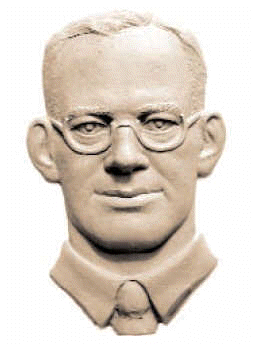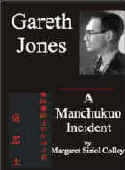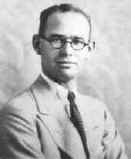Gareth Jones
[bas relief by Oleh Lesiuk]
HOME |
Stop Press |
Complete Soviet Articles & Background Information |
Précis of Gareth's
|
All Published Articles |
BOOKS
|
|
|
|
More Than Grain of Truth(2005) |
|
|
TOPICAL
'Are you Listening NYT?' U.N. Speech - Nov 2009 |
Gareth Recognised at Cambridge - Nov 2009 |
Reporter and the Genocide - Rome, March 2009 |
Order of Freedom Award -Nov 2008 |
Premiere of 'The Living' Documentary Kyiv - Nov 2008 |
Gareth Jones 'Famine' Diaries - Chicago 2008 |
Aberystwyth Memorial Plaque 2006 |
GENERAL
Scholarship Fund |
Site Map |
Links |
Legal Notices |
Sponsored Links |
Contact |
The Western Mail 21st July, 1933Craftsmen of Wales Wood-turning Traditions of the Davies BrothersSpoons, Ladles, Platters, Axe, Handles and StoolsBy GARETH JONESThree Joneses in Cenarth, Cardiganshire, were discussing wooden spoons - Sam Jones, the miller, David Jones, the blacksmith, and myself. Sam said: “Thirty years ago it was wood everywhere. For meat we use wooden dishes. My mother used to serve the meat on wood always. You rarely saw anything except wooden spoons and ‘ffiolau pren.’ They used to be rougher ‘mwy o lwmpyn,’ but now they make them daintier. If you would like to see some I shall fetch them.” Sam went into his farmhouse and returned with spoons some of which had become black and brown with age, and one of which was 40 years old. I was told the spoons were made at Abercych by James Davies, the wood turner. I set out for Abercych, in the well wooded Cych Valley, mentioned in the Mabinogion as the lands over which Pwyll, Prince of Dyfed, hunted and where he met Arawn, King of the Underworld. Handles EverywhereI found Mr. Davies in his factory. In various parts of the workshop were hundreds of shovel handles, axe handles mandril handles, for James Davies is not a craftsman in his spare time, but is an efficient whole-time wood-turner and handle-maker, and carries on the trade for which Abercych has been famous for centuries. “How long has your family been in the wood-turning craft?” I asked him. With the coracle men I can say,” he replied, “from time immemorial. Abercych is the real home of the old industry. As late as the middle seventies, seven different families, all related were in the trade and most of the inhabitants of Abercych earned their living by making spoons, ladles, bowls, platters and stools. I know my great-great-grandfather was in the craft. “I am myself 58 years old and remember seven different small workshops here in the village, each workshop with the pole lathe and all the furnaces bearing the name of Davies and related. “Before the War we were four working in the trade, my father, my two brothers and myself. I was the eldest, my brother John, the second, went to live in Cwm Lancych about 1914 and my other brother was killed in the War.” Twin MillsMr. Davies is now working with his two sons. I was shown two water wheels, one of which provided power for the turning factory, and the other, by its side, power for a flour mill. Surely there can be no place in Great Britain where a flour mill stands side by side by a wood-turning factory driven by the same mill-stream. “Your main work is, therefore, no longer hand-turning and making bowls and spoons,” I said. “No, we chiefly make handles. We send thousands of miners’ mandril handles, axe and sledge handles to Cardiff, Cross Hands, Tumble. Those handles you see over there are going to Pontyberem, and those to Cwmllynfell.” “ But you still make wooden spoons and bowls?” “Yes, and some people beg of me to make more. I could sell many more than I make, but the work is very slow.” To make the wooden vessels Mr. James Davies used to work a pole lathe, but now his factory has several modern lathes driven by water-power. About thirteen years ago he made a test of the old pole lathe and the power lathe. His father worked one and he the other, making bowls. After working all the day the power-driven lathe was only a bowl or two in front, owing to the time it took to do the important work of “chucking” and “re-chucking” the bowls. Mr. James Davies has the: reputation of being the best turner that Abercych has seen in using the hook tools (“cyllell lam”), and his spoons and bowls reveal that he is one of the most skilled of craftsmen. “You should see my brother’s work,” he says when congratulated on his skill. “He spends all his spare time in making spoons and bowls and still has he old pole lathe.” “Where does he live?” “His farm is in Llancych, up the valley.” Wooden BowlsWhen I left Mr. James Davies and drove up the Cych glen I realised why the neighbourhood was famous for its wood-turning. I have seen no valley in Wales more thickly wooded, and sycamores beloved of the wood-turner, grow every where. Near the residence of the late Sir Marteine Lloyd lies the farm of John Davies. The lawn in front of the clean cottage was covered with fleece. Mrs. Davies welcomed me, and told me that John had been out in the hay, but would come immediately. When he came, with ruddy cheeks and slightly curly reddish hair, he showed me the wooden bowls which he takes to Cardigan Fair every week. Outside, off the farmyard, he has his workshop, where he keeps a foot lathe as a curiosity and the hand lathe which he now uses. He demonstrated how be first uses his axe on the rough wood and bow the big block is carved to the final smooth graceful bowl. So Very OldThe tradition of the Davies brothers is far older than Welsh people imagine. It goes back much farther than the days when the Mabinogion made the Cych Valley renowned. It goes back to prehistoric days. Dr. Cyril Fox and Mr. Iorwerth Peate, of the National Museum of Wales, have shown that the objects made by the West Wales turners resemble in a striking manner the wooden utensils from the Swiss Lake dwellings. Mr. Iorwerth Peate, in his contribution on “Some Welsh Wood-turners,” in that valuable compilation of work by Aberystwyth students, “Studies in Regional Consciousness and Environment,” writes: “When the evidence of folk tales of buried cities in inland Welsh lakes (e.g., Maesllyn in the Tregaron bog) is also recalled, it can be argued with some probability hat the tradition of wood-turning so admirably developed in the central European lake dwellers, brought to West Britain via the Glastonbury lake dwellers, has been prolonged to our own day in the work of the West Wales turners.” |
GARETH JONES (1905 -35) |




